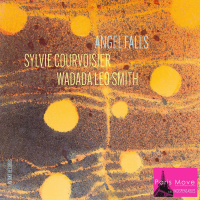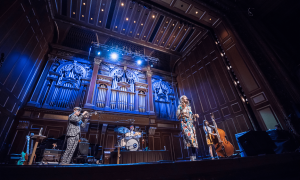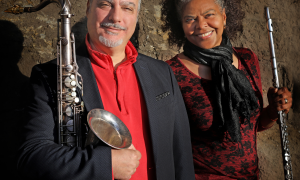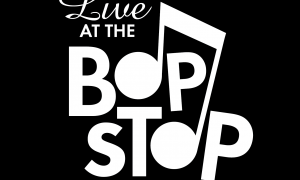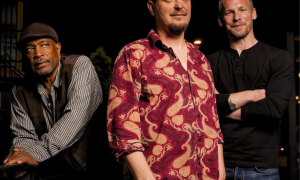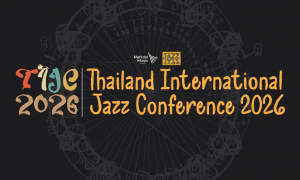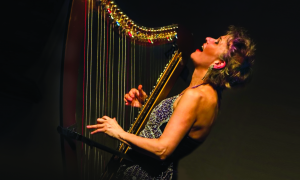In the 1960s, the female pop vocalist was largely a British phenomenon. There were plenty of girl groups in the U.S. singing pop and soul. But the stand-alone teen vocalist with mom's hairdo and a prematurely deep voice belting out tunes about cheating boyfriends and catty girlfriends never really gained traction here. As popular as Connie Francis, Brenda Lee, Dionne Warwick and Mary Wells were in the mid-1960s, they weren't quite the same as the Brit gals nor were they as adored by the record-buying public.
In fact, America's Leslie Gore, Cher and Diana Ross really came in response to British solo sensations such as Helen Shapiro, Shirley Bassey, Petula Clark [pictured] and Dusty Springfield. Many of the U.S. female hit-makers were ramped up fast by record labels here in part to stave off the troubling rise in popularity of British female vocalists who were making inroads on the U.S. charts.
Fortunately for American labels, the Brit Girl Invasion never materialized. By 1964, teenage girls in the U.S. were reaching maturity. As pillow talk gave way to makeup and skirts, American teenage girls were less interested in lyrics offered up by solo girl singers and more smitten by British boy bands. [Photo: Bill Ray for Life]
In recent years, the stand-alone British female pop vocalist has made something of a comeback with the success of Amy Winehouse and Adele [pictured]. But the golden age of this English genre ran roughly from 1960 to 1967. Sadly, the potent sound has been largely forgotten or in many cases unknown. When I ran Helen Shapiro's name past a half dozen rock and pop fans over the weekend, all said “Who?"
To be fair, there's no real reason for anyone here to know of these English gals. American audiences caught only a small fraction of the British girl sound through Dusty Springfield [pictured], Petula Clark and Shirley Bassey. At the dawn of the 1960s, before transcontinental TV broadcasts and international record distribution, the U.K.'s charts and talent were largely cut off from the U.S. To this day, most people think of the pre-Beatles rock era as largely an American affair dominated by Elvis Presley, Fats Domino and Chuck Berry.
Those who are somewhat hip to the U.K.'s early rock scene usually site Cliff Richard [pictured] and the Shadows, Freddie and the Dreamers, the Dave Clark Five, Rory Storm and the Hurricanes, Gerry and the Pacemakers and other guy groups.
Lost in the shuffle are the fabulous British girl vocalists. Many of these singers were from poor families and could belt out songs with voices that masked their true age. All were charismatic, tireless and hungry for success. And all trained their initial efforts on Europe, not the U.S., which was tightly controlled by record companies and prohibitively expensive to make a dent. So many of these singers and their managers pushed for less expensive exposure opportunities on the Continent.
As the British Invasion accelerated rapidly following the Beatles' U.S. success in 1964, many British girl singers also tried to make the leap to the U.S. Many tried by raiding the songbook of Burt Bacharach [pictured] and Hal David. Yet only a few managed to capture the hearts and imaginations of American audiences. Dionne Warwick's interpretations were more mature, closer to Americans' hearts and far better promoted.
The rest of the Brit Girls remained behind in the U.K. for a range of reasons. Some had the right sound but the wrong look. Some had the right look but an unintelligible British accent. Others who clicked with Britain's more sophisticated pop listeners didn't connect with America's quirky mass market. Or they had lousy management and even worse luck. The British girl singers who remained in the U.K. managed to eke out singing careers there, many turning to jazz. But as they aged, they slipped into semi-obscurity as new trends and younger pop singers emerged.
Looking back and listening to these British girl singers, you can't help but notice how remarkable most of them were. Some took on a lusty Northern soul sound while others had a more pixie approach. All were enormously upbeat and perky. And the songs were fabulous. You listen to the high quality of these tunes and realize there's an entire slice of pop music history here that has been all but lost. And no one here has really made a fuss over them.
To illustrate, let me share with you the best of the breed, followed by audio and video clips that show why the Brit Girls of the 1960s were so special and in many cases the molds for American counterparts:
Shirley Bassey--She was the first of this genre to have a No. 1 hit in in the U.K. in 1959 with As I Love You. Though she was 22 years old at the time, Bassey straddled both the traditional 1950s pop era and emerging mod scene of the 1960s. Her recording of the James Bond theme Goldfinger in 1964 introduced her voice to the U.S., and she had greater U.K. success with the Beatles Something than the group did itself. Here's a clip of her first hit As I Love You...
Petula Clark--Born in 1933, Clark was a teenage sensation in the late 1940s and well established by the 1950s. Her first No. 1 hit in the U.K. was Sailor in February 1961. Most people aren't aware that Downtown (1964) and her other 1965-67 hits were recorded when Clark was already in her 30s. Yet visually she looked at least 10 years younger. Here Clark takes charge on one of her monster hits, I Couldn't Live Without Your Love (1966)...
Helen Shapiro--She is perhaps the first Brit teen singer of the rock era and in my opinion the best. She scored her first No. 1 U.K. single at age 14 in August 1961 with You Don't Know followed by Walkin' Back to Happiness in October. Shapiro was so popular by 1963 that the Beatles opened for her on their first U.K. tour. Shapiro almost made it in the U.S., appearing on The Ed Sullivan Show in 1961. But she was a few years too early, and by the time the Beatles hit, her look and sound were all wrong. It didn't help that her record producer of the time foolishly turned down Misery, a song
that John Lennon and Paul McCartney had written for her. Go here to see Shapiro sing Look Who It Is with three of the Fab Four. And go here and listen to two powerful U.K. tracks from the late 1960s that show off Shapiro's staying power. But to appreciate Shapiro's visual take-charge attack, dig It Might As Well As Rain Until September...
Susan Maughan--[pictured] had just one hit with Bobby's Girl in 1962. But she continued to have success in Britain in the years that followed...
Kathy Kirby--Her big U.K. hits were Dance On in 1962 and I Belong in 1965...
Dusty Springfield--When Dusty left the
folk trio The Springfields in 1963 and went out on her own, she became one of the first British female artists to have a massive hit in the U.S., just before the Beatles' arrival, with I Only Want To Be With You in January 1964. But it was this song from 1966 that became her only No. 1 U.K. hit...
Cilla Black--Seemingly reserved, Black made up for her plain looks with sheer lung power. One of the strongest Brit girl voices, Black had her first U.K. hit in 1963 with Love of the Loved and Anyone Who Had a Heart. Unlike most of the other girl vocalists, Black was the first significant singer to come out of Liverpool at the height of the Mersey Sound. A pal of the Beatles, she was discovered by Brian Epstein, the Beatles' manager, and helped greatly by producer George Martin. Black outsold all other female recording artists in Britain during the 1960s and was Britain's second most successful act after the Beatles. Her recording of Alfie in 1966 for the U.K. film release still staggers. Yet Black never was a household name in the U.S., largely because of her less-than-glamorous looks. Dig Black's power here in 1966...
Billie Davis--Her big hit was Tell Him, in February 1963...
Sandie Shaw--Shaw's appeal was in her mod, angular looks and strong, enveloping voice. Shaw managed to combine a free-spirited shyness with a knowing delivery that won over both male and female audiences. In 1964, Shaw had a big hit here with There's Always Someone There to Remind Me. But here's her lesser-known 1965 U.K. hit, Long Live Love...
Lulu--Best known in the U.S. for To Sir, With Love in 1967, Lulu also had a hit in 1964 with Shout. Here's another one of her U.K. hits, Leave a Little Love...
The list goes on and on. Among the many other Brit girl singers during this era were Twinkle, Julie Rogers, Samantha Jones, Barbara Ruskin and Jackie Trent, who had a 1965 hit with Where Are You Now...
JazzWax tracks: Want more? If you dig Helen Shapiro as much as I do, here's a web site that lets you listen to many of her hits for free. And if you want to know more about the swinging British girl-singer movement, this European site (ReadySteadyGirls.eu) has loads of information and audio clips. These girls didn't have Phil Spector, the Motown machine or vital radio access to U.S. markets. But what many lacked in political power they made up for with quaint charm, youthful talent and raw confidence.
This story appears courtesy of JazzWax by Marc Myers.
Copyright © 2026. All rights reserved.






